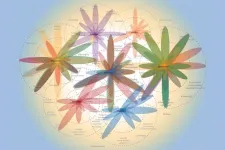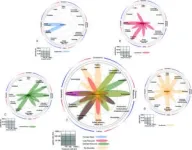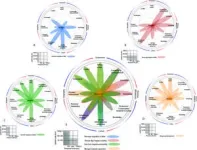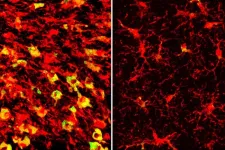(Press-News.org) Spurred by the current climate crisis, there has been a heightened attention within the scientific community in recent years to how past climate variation contributed to historic human migration and other behaviors.
Now, an international group of scientists — including archaeologists, historians, climate scientists, paleo-scientists, a volcanologist and others — are calling for a strengthened commitment to transdisciplinary collaboration to study past and present human-environmental interactions, which they say will advance our understanding of these complex, entangled histories. Their recommendations were published Nov. 22 in Science Advances.
In doing so, the group has introduced a new tool, the “dahliagram,” to enable researchers to analyze and visualize a wide array of quantitative and qualitative knowledge from diverse disciplinary sources and epistemological backgrounds.
“Backed by higher-resolution data concerning past climates, environmental change is increasingly seen as a crucial factor in debates concerning social, political and economic change — and human behavior generally — through time and space,” said Michael Frachetti, a professor of archaeology in Arts & Sciences at Washington University in St. Louis, and a lead author of the paper.
“Yet interdisciplinary attempts to cross data from history, climate science, archaeology and ecology to model past social-environmental interactions are challenged by mismatched units of measure and degrees of uncertainty,”
The dahliagram attempts to overcome those challenges by creating a universal and visual language to enable cross-disciplinary collaboration. Moreover, it allows researchers to compress vast amounts of data into a single, easy-to-interpret model.
Named for the dahlia flower whose petals bloom in concentric arrays , the dahliagram’s “petals” illustrate the relative impact of different pull and push factors contributing to human behavior over time. For example, the petals could represent the climate and environment, conflicts, politics and power, technology and resource availability. These are just examples, though. One of the benefits of the tool is that it is fully customizable to meet each study’s needs.
According to Frachetti, the tool is meant to stimulate conceptual thinking and promote critical engagement, dialogue and debate. It welcomes data from domains of research like history or archaeology that are not easily quantified as factors in understanding behaviors like migration. And it requires the user to think beyond simply causality and consider the unique intersection of social, economic, political and environmental conditions for each case.
“The tool not only allows for a more nuanced understanding of complex data, but also can be a ‘gut check’ — a way of testing your hypotheses and assumptions,” Frachetti said.
Testing the dahliagram
To test the capabilities of the proposed dahliagram tool, the group created three models that assess the impacts of a range of factors on local- to large-scale mobility in three pivotal regions of world history: eastern Africa, inner Eurasia and the North Atlantic. These selected case studies range in chronological scale from decades to centuries to millennia.
Although the dahliagram is a universal device for human-environmental research, for the purpose of this study, the researchers focused on human mobility as a behavioral response.
In each model, “movement” is placed at the center of the dahliagram while different factors are represented in a surrounding array of petals. The team synthesized volumes of research and data on each factor and then ranked it according to its influence from low to high over three concentric rings of increasing intensity.
“One of the challenges to studying past phases of migration is that there’s very rarely a single driver. It’s usually a multitude of things that are impacting the people. Changes in the climate or access to resources could be one factor, but it’s usually accompanied by something like war, new innovations, economic or political pressures, etc. The people in the Sahara, for example, have adapted to desertification for more than 5,000 years, making a simple driver for their patterned mobility, or a discrete migratory event, rather unlikely,” Frachetti said.
An interesting thing happened when the team compared the dahliagram models for each of the three case studies. Although they are separated historically by hundreds of years and thousands of kilometers, unexpected parallels between the cases became obvious to the team.
“Population movement within emergent empires in both Asia and East Africa appears to be rooted in similar forces of political and social identity, as well as ambitious interests to acquire regional resources and stimulate trade and connectivity,” the authors write. “Environmental factors were an omnipresent concern but appear to be outweighed by factors such as conflict and sovereignty.
“The historical implications of mobility within these formative empires in their respective era and region are unique, but only when visualized in the dahliagram do we see the shared correlations across an array of factors that may produce fruitful onward investigation into their behavioral similarities at the human-environmental nexus.”
Overall, the group found the dahliagram to be effective in assessing population movements that occurred within richly documented historical time scales, as well as over long periods of time.
“We now hope that our new dahligram approach will be applied by many scholars from different fields across the natural and social sciences and the humanities to enhance interdisciplinary investigations into the entanglements between nature and humans,” said Ulf Büntgen, a professor of environmental systems analysis in the Department of Geography at University of Cambridge, U.K., and a lead author of the paper.
Inspired by and built for transdisciplinary research
In recent years, the academic community has embraced the concept of transdisciplinary research. Like interdisciplinary or multidisciplinary research, transdisciplinary research connects scholarship from various disciplines to more fully grasp the complexity of problems and enable creative problem solving and discovery. What makes transdisciplinary research unique is that it incorporates the perspectives of non-academic stakeholders, including members of tribes and ethnic groups, historians, artists and other subject-matter experts.
Translating and effectively communicating complicated findings and uncertainties across disciplines, and with non-academic stakeholders, is not without its challenges, though. In fact, the idea for the dahliagram was inspired by the group’s ongoing transdisciplinary work in the “Volcanoes, Climate and History” project, which was convened by Ulf Büntgen and Clive Oppenheimer from the University of Cambridge and supported by The Center for Interdisciplinary Research (ZiF: Zentrum für interdisziplinäre Forschung) at Bielefeld University in Germany.
The dahliagram not only enables researchers to synthesize data from various sources with different metrics, it also helps ensure equity among the various contributors, Frachetti said. Moreover, the visual nature of the dahliagram is especially helpful when communicating with various stakeholders.
“This tool allows us to gather communities of specialists and fairly and collectively express our knowledge in a way that that is on equal footing, rather than allowing one discipline to lead the way. I think that that kind of equity is a significant component of what the dahliagram provides,” he said.
Ultimately, the team hopes the dahliagram will be adopted within the scientific community to stimulate further explorations of complex human behaviors by leveraging multidisciplinary team building and consensus.
According to Nicola Di Cosmo, a historian and Luce Foundation professor in East Asian Studies at the Institute for Advanced Study in Princeton, NJ and co-author of the study, the addition of the dahliagram will expand the analytical tools available for historical research.
“Historians may be encouraged to use the dahliagram to translate into a visual representation a wealth of data from multiple sources and different disciplines and thus avoid monocausal explanations derived from limited datasets,” he said.
As for scientists, Frachetti said that some might initially have hesitations about the tool because it does not provide hard facts, but he hopes the community will come to appreciate the tool for what it does provide: a visualization of the facts.
“The dahliagram is a contextual tool that’s meant to help you question your assumptions and consider other explanations. And that’s really important because even our best ‘hard facts’ — things like tree rings and our measurements to monitor the planet’s health — are conditioned by assumptions and uncertainty.”
In addition to Frachetti and Büntgen, the following experts contributed to this paper: Nicola Di Cosmo, Institute for Advanced Study; Jan Esper, Johannes Gutenberg University; Lamya Khalidi, Université Côte d’Azur CNRS, CEPAM; Franz Mauelshagen, University of Bielefeld; Clive Oppenheimer, University of Cambridge; and Eleonora Rohland, University of Bielefeld.
END
New tool to enable exploration of human-environment interactions
Universal device will allow transdisciplinary collaboration globally
2023-11-22
ELSE PRESS RELEASES FROM THIS DATE:
Researchers pinpoint brain area where people who are blind recognize faces identified by sound
2023-11-22
WASHINGTON – Using a specialized device that translates images into sound, Georgetown University Medical Center neuroscientists and colleagues showed that people who are blind recognized basic faces using the part of the brain known as the fusiform face area, a region that is crucial for the processing of faces in sighted people.
The findings appeared in PLOS ONE on November 22, 2023.
“It’s been known for some time that people who are blind can compensate for their loss of vision, ...
Cognitive ability mattered in the UK’s vote for Brexit, University of Bath research shows
2023-11-22
Susceptibility to misinformation and disinformation likely to have played part in Leave vote
New research from the University of Bath’s School of Management finds that higher cognitive ability was strongly linked to voting to Remain in the 2016 UK referendum on European Union Membership.
The study shows that cognitive skills including memory, verbal fluency, fluid reasoning and numerical reasoning, were correlated with how people decided to vote.
Lead author Dr Chris Dawson, from the University of Bath’s School of Management, said: “This study adds to existing academic evidence showing that low ...
Autonomous excavator constructs a 6-meter-high dry-stone wall
2023-11-22
ETH Zurich researchers deployed an autonomous excavator, called HEAP, to build a six metre-high and sixty-five-metre-long dry-stone wall. The wall is embedded in a digitally planned and autonomously excavated landscape and park.
The team of researchers included: Gramazio Kohler Research, the Robotics Systems Lab, Vision for Robotics Lab, and the Chair of Landscape Architecture. They developed this innovative design application as part of the National Centre of Competence in Research for Digital Fabrication ...
Depression, anxiety, and stress frequently co-occur in Black pregnant individuals
2023-11-22
November 22, 2023 — Black pregnant individuals frequently experience more than one mental health concern, according to findings published by Susan Gennaro, PhD, RN, FAAN, Professor in the William F. Connell School of Nursing at Boston College, and colleagues in The Nurse Practitioner. They say prenatal screening and treatment for stress is warranted in addition to care of depression and anxiety. The Nurse Practitioner is part of the Lippincott portfolio of Wolters Kluwer.
"Prenatal interventions for Black people should aim to address mental health distress and treat high depression, anxiety, and stress," the research ...
UTA, DOE lab partner to prove new atomic cooling techniques
2023-11-22
The U.S. Department of Energy has awarded associate professor of physics Benjamin Jones a $540,000 grant to initiate a new collaborative research partnership between The University of Texas at Arlington and the Pacific Northwest National Laboratory in Richland, Washington. The project aims to prove a new atomic cooling approach required for the next generation of neutrino mass research.
Neutrinos are the most abundant particles with mass in the universe. Every time atomic nuclei come together (in the case of stars like the sun) or break apart (such as in nuclear ...
Low-pH-dependent RNA binding and oligomerization of SID-1 transmembrane family proteins: implications for their RNA transport activity
2023-11-22
In C. elegans, the protein SID1 plays a crucial role in the systemic RNA interference process by facilitating the transport of exogenous double-stranded RNA into the cytoplasm. Previously, Chen-Yu Zhang's group has already demonstrated that intact plant miRNA found in dietary sources can be absorbed through the mammalian digestive system and mediate cross-kingdom gene regulation. Mammalian SID-1 transmembrane family proteins, namely SIDT1 and SIDT2, have attracted considerable attention due to their role in facilitating the uptake of regulatory exogenous small RNAs, such as small interfering RNA (siRNA) and plant-derived ...
Nutrient found in beef and dairy improves immune response to cancer
2023-11-22
Trans-vaccenic acid (TVA), a long-chain fatty acid found in meat and dairy products from grazing animals such as cows and sheep, improves the ability of CD8+ T cells to infiltrate tumors and kill cancer cells, according to a new study by researchers from the University of Chicago.
The research, published this week in Nature, also shows that patients with higher levels of TVA circulating in the blood responded better to immunotherapy, suggesting that it could have potential as a nutritional supplement to complement clinical treatments for cancer.
“There are many studies trying to decipher ...
Overdose deaths increased in pregnant and postpartum women from early 2018 to late 2021
2023-11-22
Drug overdose deaths rose markedly between January to June 2018 and July to December 2021 among 10- to 44-year-old girls and women who were pregnant or pregnant within the previous 12 months, according to a new study by researchers at National Institute on Drug Abuse (NIDA) at the National Institutes of Health. Overdose mortality more than tripled among those aged 35 to 44 during the study period, from 4.9 deaths per 100,000 mothers aged 35 to 44 with a live birth in the 2018 period to 15.8 in the 2021 period. Over 60% of these pregnancy-associated overdose deaths occurred outside healthcare settings, ...
Lowering a form of brain cholesterol reduces Alzheimer’s-like damage in mice
2023-11-22
In Alzheimer’s disease and related dementias, cognitive decline is driven by the overaccumulation of a normal brain protein known as tau. Wherever tau builds up, nearby brain tissue starts to degenerate and die.
Now, researchers at Washington University School of Medicine in St. Louis have found — in mice — that Alzheimer’s-like tau deposits in the brain lead to the accumulation of a form of cholesterol known as cholesteryl esters, and that lowering cholesteryl ester levels ...
Segregated patterns of hospital care delivery and health outcomes
2023-11-22
About The Study: This study of Medicare claims data for 4,386 hospitals found that higher segregation of hospital care was associated with poorer health outcomes for both Black and white patients, with significantly greater negative health outcomes for Black populations, supporting racial segregation as a root cause of health disparities. Policymakers and clinical leaders could address this important public health issue through payment reform efforts and expansion of health insurance coverage, in addition to supporting upstream efforts to reduce racial segregation in hospital ...
LAST 30 PRESS RELEASES:
Australian team discover why quantum computers have memory problems over time
What determines the fate of a T cell?
Candida auris: genetic process revealed which could be treatment target for deadly fungal disease
Groundbreaking discovery turns household plastic recycling into anti-cancer medication
Blocking a key inflammatory pathway improves liver structure and vascular function in cirrhosis, study finds
Continuous spread: Raccoon roundworm detected in nine European countries
HKUST Engineering researchers developed a novel photodetector to enhance the performance of on-chip light monitoring
Strategic river sensors could have forewarned of Texas Camp flood disaster
Drone sampling of whale breath reveals first evidence of potentially deadly virus in Arctic
Roman soldiers defending Hadrian’s Wall infected by parasites, study finds
Pinochet’s prisoners were tormented with music but still found solace in it, a new book reveals
Fertility remains high in rural Tanzania despite access to family planning
AI-assisted device can improve autism care access
Kinetic careers
Uncovering how parasitic plants avoid attacking themselves to improve crop resistance
Nanoparticle vaccine strategy could protect against Ebola and other deadly filoviruses
Study finds brain care score can predict risk of stroke across racial groups
Key lung immune cells can intensify allergic reactions
Do hormones explain why women experience more gut pain?
New materials conduct ions in solids as easily as in liquids
Breakthrough of the Year: Renewable energy begins to eclipse fossil fuel-based sources
LLM use is reshaping scientific enterprise by increasing output, reducing quality and more
Introducing LightGen, a chip for ultra-fast, ultra-efficient generative AI
Astronomers see fireworks from violent collisions around nearby star
ACC/AHA issue new guideline on managing congenital heart disease in adults
Cosmic crash caught on camera
Is talented youth nurtured the wrong way? New study shows: top performers develop differently than assumed
Ants: An untapped resource in the development of antibiotics?
Archaeologists use AI to create prehistoric video game
Mitochondria migrate toward the cell membrane in response to high glucose levels
[Press-News.org] New tool to enable exploration of human-environment interactionsUniversal device will allow transdisciplinary collaboration globally





